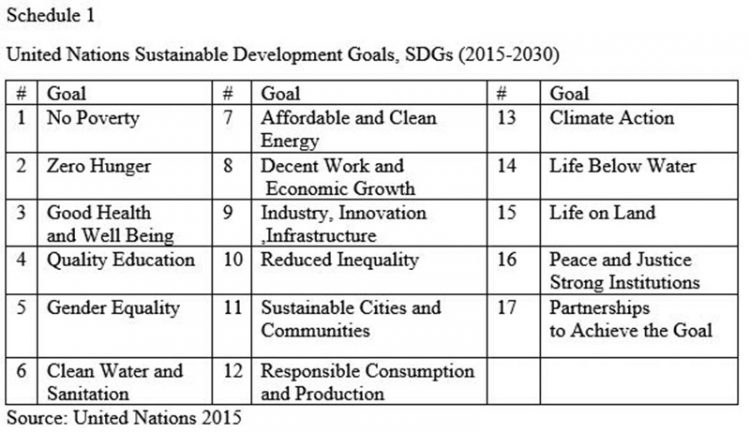Introduction
Today’s column considers the Buxton Proposal as it relates to the United Nations undertaking to pursue sustainable development via a partnership among its Member Countries. The agreed framework for global action is enshrined in the United Nations Sustainable Development Goals, UN SDGs. There are 17 such goals. In turn, these are linked to 169 listed targets, 3110 events and 5,484 actions, all of which apply to both developed and developing member countries, for the period 2015 to 2030.
The UN SDGs are the product of decades-long efforts to build a global framework for sustainable development and its supporting goals, policies and programmes, along with their financing requirements. The UN has proclaimed that, taken together, these goals constitute a “shared blueprint of peace and prosperity for the people and the Planet, now and into the future”.
Evolution
The evolution is clear. Going back nearly three decades ago in 1992, the Earth Summit was held in Brazil. By 2000, the Millennium Development Goals were formulated and subscribed to at the United Nations Millennium Summit. The overriding global priority remains the ending of poverty and reduction of inequality, and other deprivations globally. The SDGs are premised on the proposition that, meeting these challenges go “hand in hand” with other strategies. For example, improving health and education; investing in economic growth; tackling climate change adverse impacts; and, safeguarding earth’s resources, particularly its oceans and forests.
For readers’ convenience, Schedule 1 below lists the 17 SDGs agreed to at the United Nations 2015 Global Summit. While all the goals in some manner directly or indirectly engage issues embedded in the Buxton Proposal, Goals 1 and 13 directly relate to its aims and purposes. This is addressed in the next sections
Poverty & INEQUALITY- GOAL 1
The Buxton Proposal is explicitly modelled on Goal 1, which unambiguously identifies the topmost priority of the UN SDGs as the ‘eradication of poverty in all its forms and dimensions everywhere’. Indeed, this is held to be by the United Nations as the only true path to sustainable development. This premise also undergirds the Buxton Proposal
I remind readers here that the Buxton Proposal has been put forward for a pilot and feasibility study prior to its adoption by the Authorities. At that stage it would become possible to determine how the Proposal stands up in regard to the targets set by Goal 1 in areas of performance such as extreme poverty reduction, child poverty and variable household income.
At the base of Goal 1 policies is the manifest emphasis on transfers of income, wealth and resources, access and opportunity by advantaged individuals, groups, communities, nations and regions to their dis-advantaged counterparts through sustainable development processes.
Finally, it should be recognized that the SDGs build on the accomplishments of the Millennium Development Goals, including bringing one billion persons out of extreme poverty. Regrettably, the Covid-19 pandemic has led to dramatic reversals in these global gains.
CLIMATE ACTION-GOAL 13
Given the long history of human activity on Planet Earth the evidence suggests that such activity, largely by way of man-made greenhouse gas emissions, is leading to global warming. Thus far, this has produced adverse climate impacts worldwide. A major contributing factor, but by no measure the only one of these, is emissions, which come from fossil fuels utilization as an energy source.
My previous extended analysis of this widely held view [that I share] is subject to at least two stipulations from Guyana’s perspective. These are: 1) going forward, the likely window of opportunity for a small poor open dependent economy faced with this situation and the actualization of world class petroleum finds and consequent production of competitive oil and gas in the coming decades; and 2) what does the historical record reveal as Guyana’s best response for adapting and coping with the coming adverse climate impacts.
Goal 13 calls for national efforts to reduce greenhouse gas emissions; to raise resilience; to reduce negative climate impacts; to develop mitigating and adaptive capacity to cope with increasing threats and challenges; and more generally to promote the mainstreaming of climate action policies, programmes and projects.
Of note, Goal 13 is irretrievably linked to the wider longstanding initiatives of the United Nations Framework Convention on Climate Change, UNFCCC; the Paris Agreement and the recent COP 26 global climate Summit. That Summit ended with the Glasgow Climate Compact, which given global expectations looks disappointingly anemic. The failure to agree on the phasing out of coal as a high greenhouse gas emitter is a subtext to the lack of ambition shown in the lip serving attention paid to the 1.5 degrees Celsius global temperature reduction target for global warming.
Conclusion
Two major conclusions follow from the above portrayal. These will be discussed in next week’s column as I proceed to demonstrate the congruence between the Buxton Proposal and the UN SDGs.







